|
McDonnell-Douglas
F-4B Phantom II
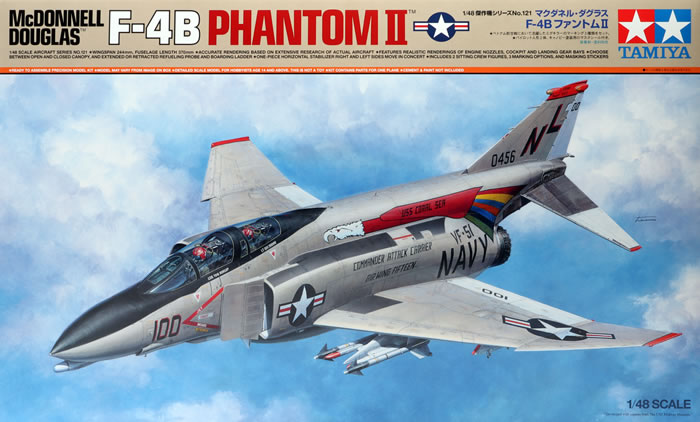
Tamiya, 1/48 scale
S
u m m a r y |
| Catalogue Number: |
Tamiya Kit No. 61121 - McDonnell-Douglas F-4B Phantom II |
| Scale: |
1/48 |
| Contents and Media: |
374 parts in light grey plastic (298 for the airframe plus 76 for weapons); six parts in clear plastic; two polythene caps; one masking sheet; two decal sheets. |
| Price: |
USD$73.98 plus shipping available online from Lucky Model
GBP£89.99 EU Price (GBP£74.99 Export Price) plus shipping available online from Hannants |
| Review Type: |
FirstLook |
| Advantages: |
Accurate; high level of detail; outstanding surface features including crisply recessed panels and subtle rivet lines where appropriate; useful options including alternative position folding wings, refuelling probe and canopy; poseable control surfaces, moveable stabilisers; auxiliary air intake detail and more; clever and modeller-friendly parts breakdown; includes canopy masks. |
| Disadvantages: |
None noted. |
| Conclusion: |
Although you might quite reasonably assume that the Phantom is a simpler subject than the swing-wing Tomcat, Tamiya's parts count for these two iconic US Navy fighters is almost identical - 373 grey plastic parts for the F-14A and 374 gey plastic parts for this new F-4B. This points to the newer kit's included options and high level of detail.
Tamiya's 1/48 scale F4B Phantom II continues their proud tradition of accurate, well-detailed, thoughtfully designed and modeller friendly kits. Surface textures are beautifully restrained and the various options including alternative positions for the folding outer wing panels are thoughtful touches.
It is true that there have been plenty of 1/48 scale Phantom kits before now, but this is the first time that we have a Tamiya Phantom; and that means an accurate, well detailed and cleverly engineered kit that you will build with a smile on your face from start to finish!
Highly Recommended. |
Reviewed by Brett Green

The McDonnell Douglas F-4 Phantom II is a tandem two-seat, twin-engine, all-weather, long-range supersonic jet interceptor and fighter-bomber originally developed by McDonnell Aircraft for the United States Navy.
Proving highly adaptable, it first entered service with the Navy in 1961 before it was adopted by the United States Marine Corps and the United States Air Force, and by the mid-1960s it had become a major part of their air arms.
Phantom production ran from 1958 to 1981 with a total of 5,195 aircraft built, making it the most produced American supersonic military aircraft in history, and cementing its position as an iconic combat aircraft of the Cold War.
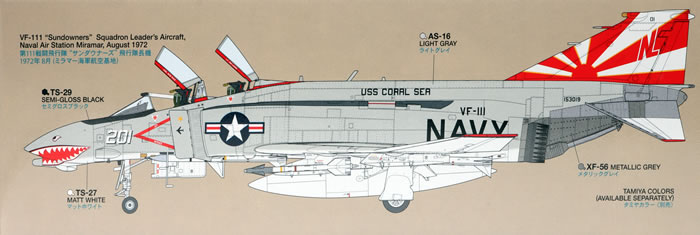
The Phantom is a large fighter with a top speed of over Mach 2.2. It can carry more than 18,000 pounds (8,400 kg) of weapons on nine external hardpoints, including air-to-air missiles, air-to-ground missiles, and various bombs. The F-4, like other interceptors of its time, was initially designed without an internal cannon. Later models incorporated an M61 Vulcan rotary cannon. Beginning in 1959, it set 15 world records for in-flight performance,[6] including an absolute speed record and an absolute altitude record.
The F-4 was used extensively during the Vietnam War. It served as the principal air superiority fighter for the U.S. Air Force, Navy, and Marine Corps and became important in the ground-attack and aerial reconnaissance roles late in the war. During the Vietnam War, one U.S. Air Force pilot, two weapon systems officers (WSOs), one U.S. Navy pilot and one radar intercept officer (RIO) became aces by achieving five aerial kills against enemy fighter aircraft.

The F-4 continued to form a major part of U.S. military air power throughout the 1970s and 1980s, being gradually replaced by more modern aircraft such as the F-15 Eagle and F-16 Fighting Falcon in the U.S. Air Force, the F-14 Tomcat in the U.S. Navy, and the F/A-18 Hornet in the U.S. Navy and U.S. Marine Corps.*
Another Phantom?
Hasegawa launched their 1/48 scale Phantom back in 1982 with the F-4J. Their F-4B/N followed in 1983.
For many years this was the best 1/48 scale Phantom available, being generally accurate and an easy build. However, panel lines were raised, detail was simple, the rear cockpit was not correct for an F-4B and ordnance was very limited.
It was therefore with great expectation that modellers awaited a successor. That successor arrived in 2012 with Academy's all-new 1/48 scale F-4B Phantom II. This was certainly an improvement on the 1980s Hasegawa Phantoms, with plenty of ordnance, recessed panel lines, a high level of detail and some innovations including a single-piece fuselage.
Zoukei-Mura joined the party in 2016 with a beautiful new F-4J Phantom followed by other late variants, but they have not yet produced any thin-wing early Phantoms.
So what has Tamiya delivered us?
Tamiya's debut 1/48 scale Rhino represents a late-version F-4B Phantom II with thin wings and narrow main wheels.
The kit comprises 374 parts in light grey plastic (298 for the airframe plus 76 for weapons), six parts in clear plastic, two polythene caps, one masking sheet and two decal sheets.
Moulding quality is perfect. Surface detail is some of the best that you will ever see in 1/48 scale, mainly by way of very finely recessed panel lines, with some selective rivets and raised detail. The panel lines are comparable to scaled-down versions of the surface detail on Tamiya's benchmark 1/32 scale kits.
Please note that the surface detail looks better in person - it is difficult for the photographs to full justice to the gorgeous panel lines on the pale coloured plastic.
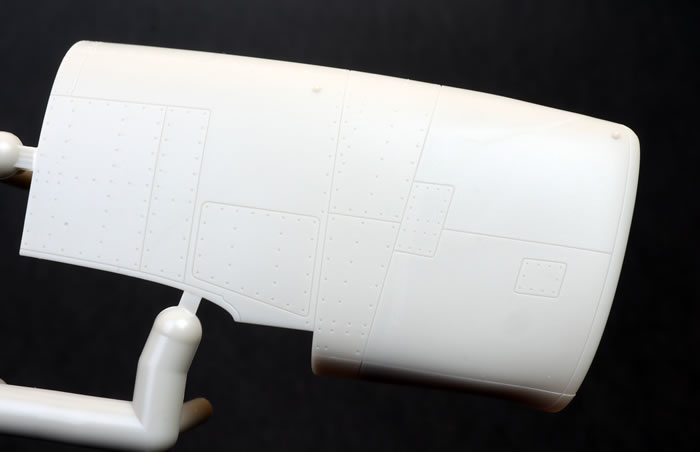
The fuselage is broken down into a full-length starboard half with the port side split into the nose section and aft fuselage. This will presumably accommodate different variants further down the track.
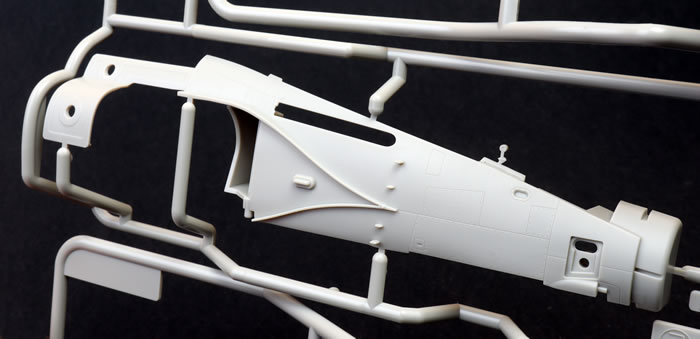
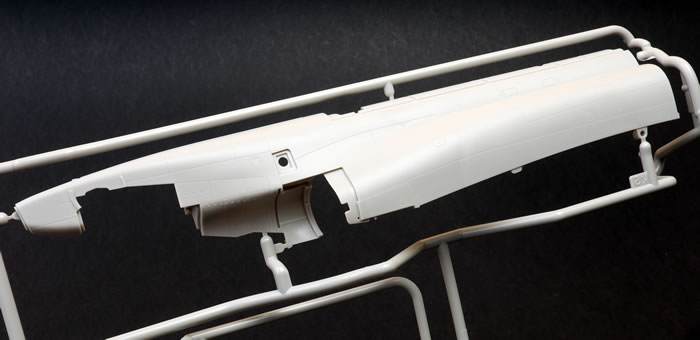
Detail is excellent throughout.
The cockpit is correct for a late F-4B. Two styles of the aft station instrument panels are offered depending on which marking option you choose.
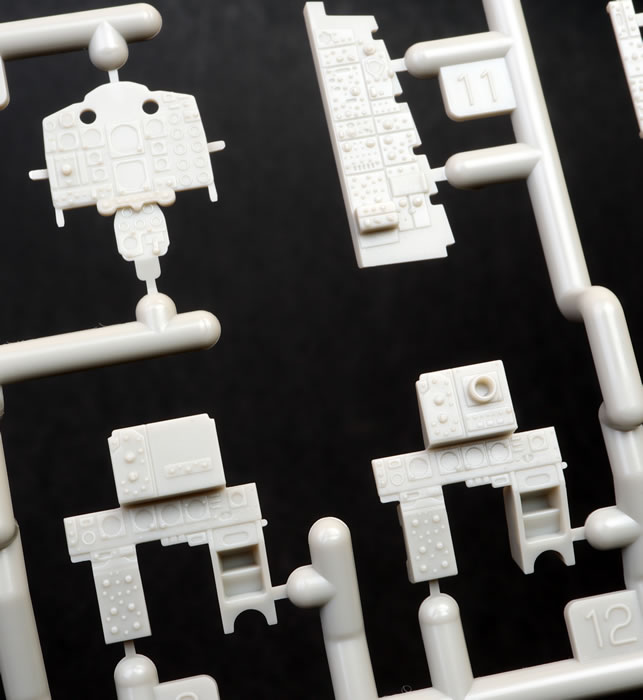
Instrument panels and side consoles comprise crisp raised detail. These should look great after careful painting and dry-brushing.
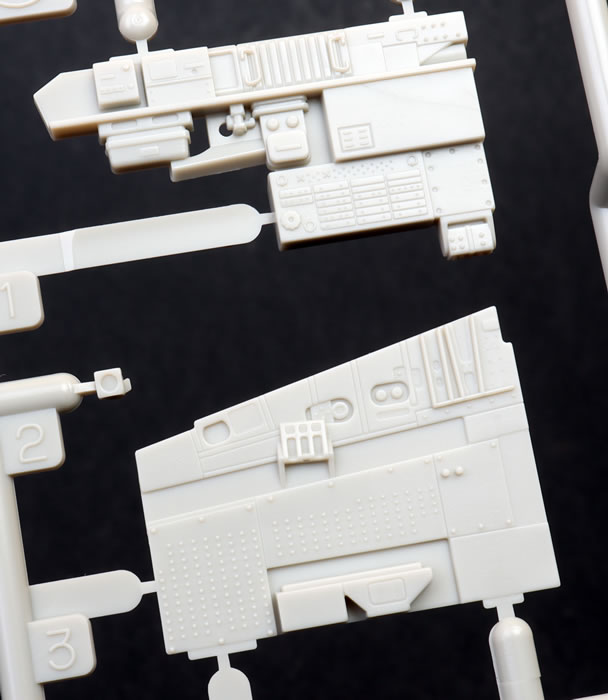
The seats are well detailed, being made up from ten parts each.
Two aircrew figures are supplied (they have different arms for individuality), but decal harness straps are also included if the crew figures are not used. I particularly like that there are squadron marking decals for the crew helmets on each of the three options.
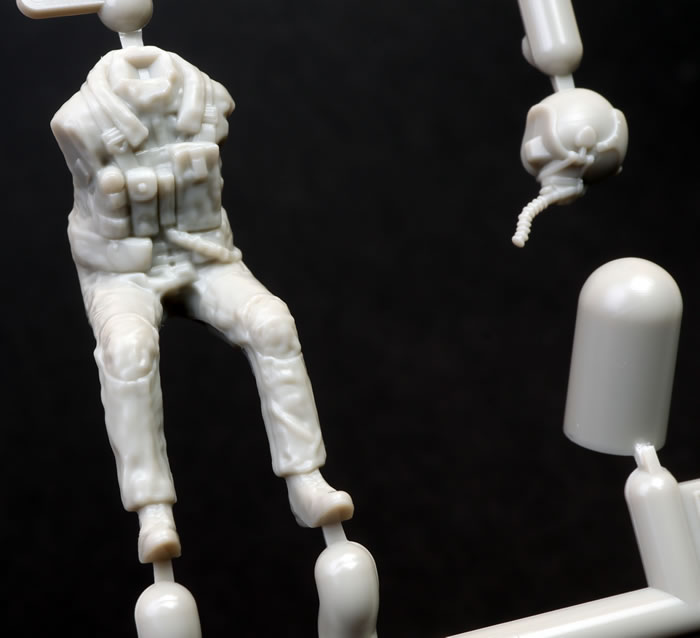
The refuelling probe may be depicted extended or retracted.
Intakes and exhausts are full length with fan and flame holder detail at the ends.
The nozzles are very impressive sub-assemblies made up from six panels each that attach to the base. Detail is amazing inside and out.
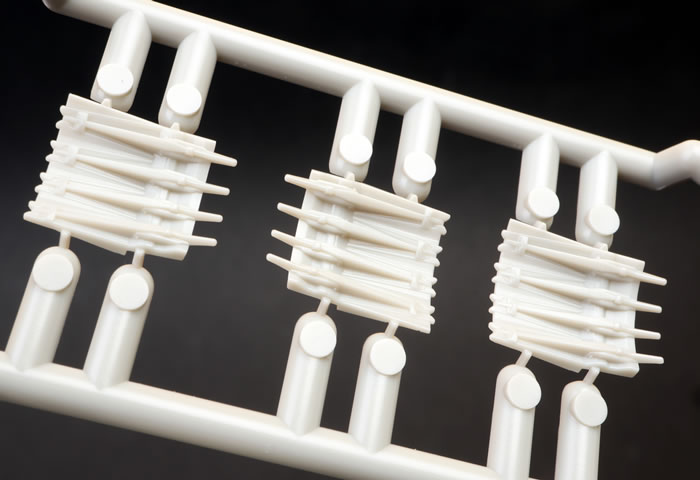
The opening for the main wheel wells are moulded along with lovely underside auxiliary air intake door detail. This area may be displayed thanks to the open air exhaust outlets.
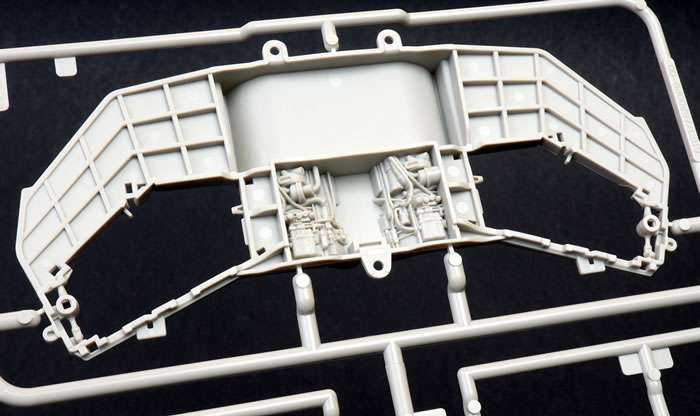
The wheels are all injection moulded plastic. No vinyl tyres here - hurrah!
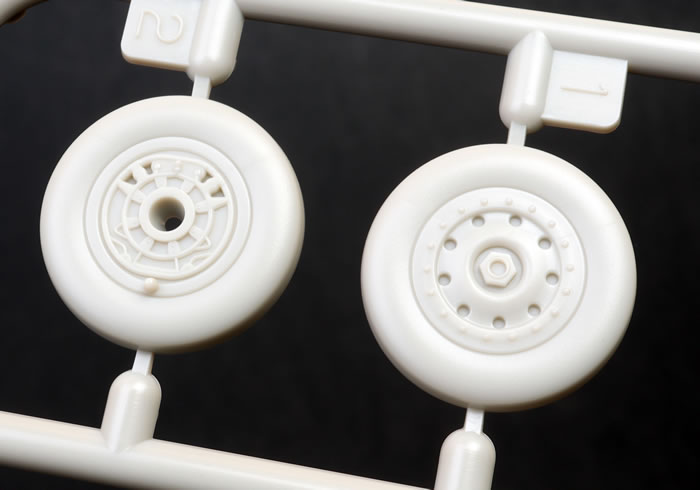
The wings are moulded as separte upper inboard halves - left and right - with the lower centre section moulded as a single part.
Separate outer wing sections are included. These may be posed folded or deployed. Nice hinge detail is provided in the case of the folded option. The outer panels are held in place with very stout tabs. These will add to stability and will also ensure the correct angle for the outer wing panels, whether folded or deployed.
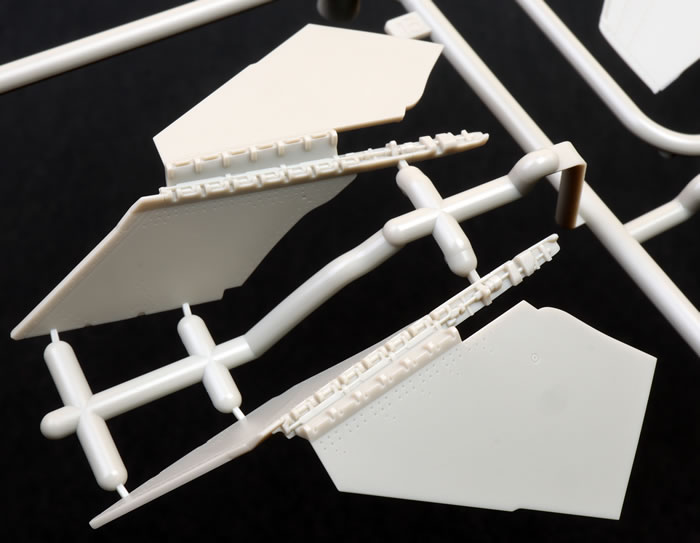
Flaperons and speed brakes are separate parts and may be posed to taste.
The stabilisers are moulded as one main part with built-in centre mounts that set the correct angle of droop. Polythene caps are used to permit the stabilisers to move freely after assembly.
Slotted and non-slotted are included in the box, although only the slotted version is used for this late F-4B variant.
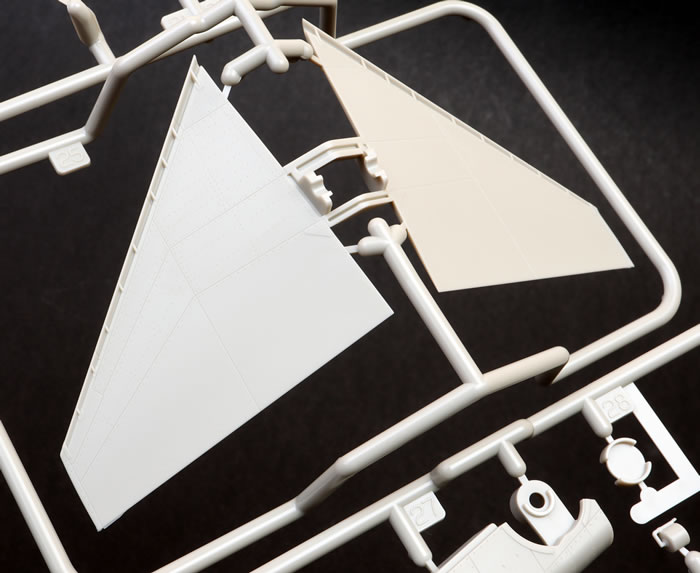
Clear parts are thin and free from distortion.
Andreas Bwck has made an interesting observation about the windscreen:
"The construction of the windshield is most interesting, especially the sides. On the real plane they do NOT attach where they meet the airframe but they go some centimeneters lower. The metal we see at the boundary between airframe and clear side window is just a blending fairing. Tamiya seems to be the first manufacturer to understand this."
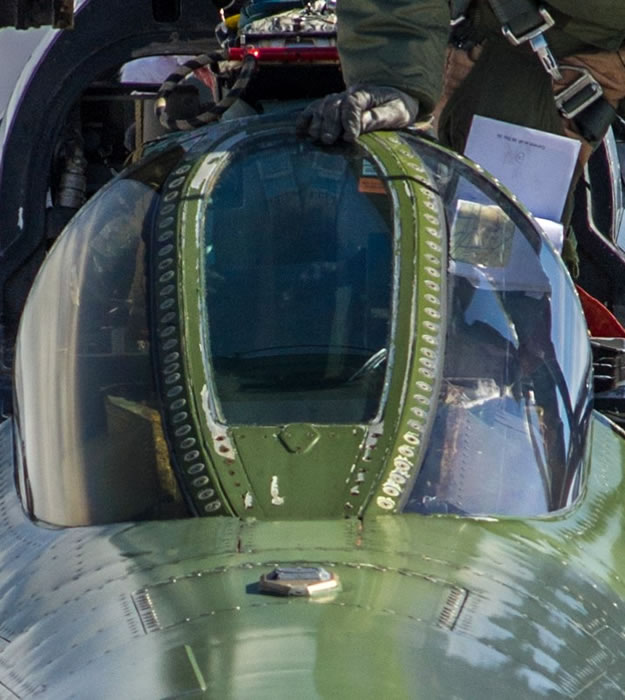
The windscreen is moulded with a clear section of the upper nose, so there is virtually no risk of messy glue marks on the finished model.
Tamiya supplies separate canopy sections should you wish to pose these parts open.

A single canopy part for the closed option is also included. This will help make sure that your clear parts are properly lined up and free from gluey fingerprints!

Tamiya has included one of the weapons sprues that were previously seen in their Tomcat kits, but with the AIM-54A Phoenix missiles clipped off.
The weapons on the two sprues in this kit are AIM-7E Sparrow missiles and AIM-9G/H Sidewinders. The Sidewinders are split into forward and rear sections. The sprues also appear to have the forward halves of later Sidewinders too.
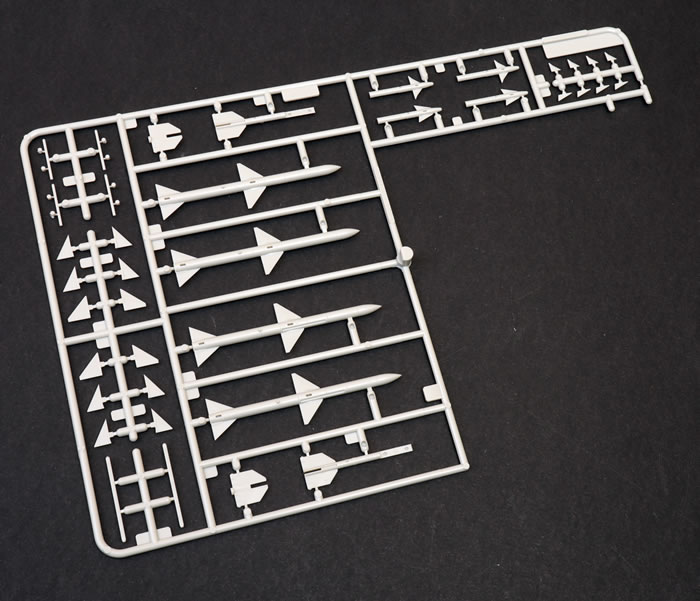
A sheet of self-adhesive canopy masks round out the package.
Markings
Markings are supplied for three aircraft:
- VF-51 "Screaming Eagles" CAG Bird, USS Coral Sea, May 1972.

Colour and registration look good.
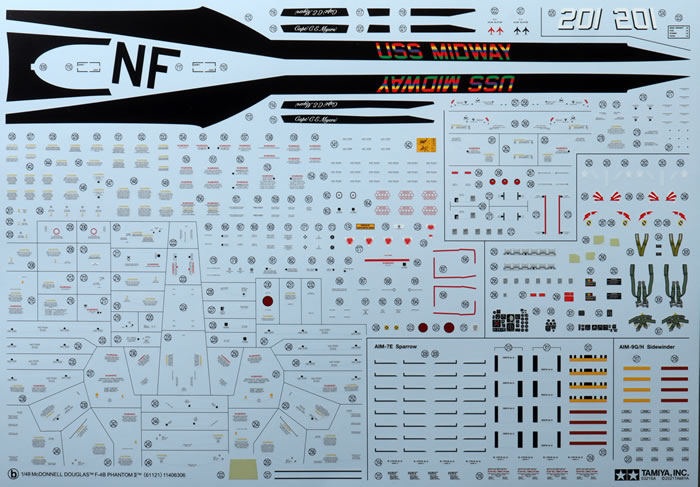
A second decal sheet includes stencils, harness straps, decals for the crew's helmets, and markings for the weapons.
Although you might quite reasonably assume that the Phantom is a simpler subject than the swing-wing Tomcat, Tamiya's parts count for these two iconic US Navy fighters is almost identical - 373 grey plastic parts for the F-14A and 374 gey plastic parts for this new F-4B. This points to the newer kit's included options and high level of detail.
Tamiya's 1/48 scale F4B Phantom II continues their proud tradition of accurate, well-detailed, thoughtfully designed and modeller friendly kits. Surface textures are beautifully restrained and the various options including alternative positions for the folding outer wing panels are thoughtful touches.
It is true that there have been plenty of 1/48 scale Phantom kits before now, but this is the first time that we have a Tamiya Phantom; and that means an accurate, well detailed and cleverly engineered kit that you will build with a smile on your face from start to finish!
Highly Recommended.
*Background information courtesy of Wikipedia
Purchased by reviewer
Review Text Copyright © 2016 by
Brett Green
Page Created 15 July, 2021
Last updated
16 July, 2021
Back to HyperScale Main Page
Back to Reviews Page |
